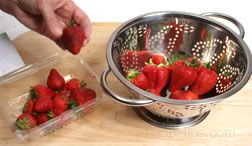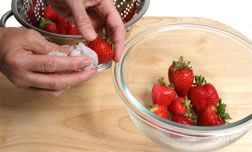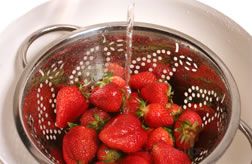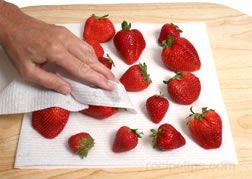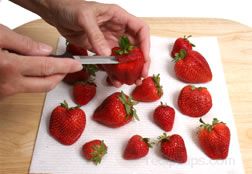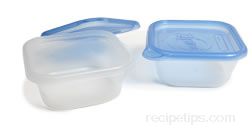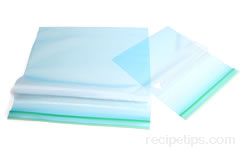|
Strawberry Preparation | Strawberry Cooking | Freezing Strawberries | Tips
Strawberries |
|
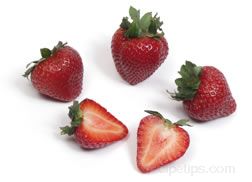
Large, juicy, red berries that are very sweet when ripe and grow on a low-growing perennial plant that has horizontal runners that spread along the ground. The strawberry plants are generally replaced after 3 or 4 seasons to insure productivity of the crop. The berries that we eat are not actually the fruit. They are the swelling of the plant's stalk that happens after the flowers have been pollinated. The tiny seeds that cover the berries are actually the real fruit. There are hundreds of different varieties of cultivated strawberries, which vary in size, shape, juiciness, texture, and sweetness. There are also wild strawberries, which are much smaller than the cultivated varieties, but they are juicier and more flavorful. Strawberries are harvested at different times throughout the year in different locations. California and Florida produce the majority of the strawberries in the United States. Strawberries are high in vitamin C, manganese and dietary fiber. There also have a high rate of antioxidant power. |
|
Uses:
Ripe strawberries are often eaten raw as whole, sliced or crushed berries. When sugar is added to strawberries, their natural juices are drawn out and crushed berries will produce a sauce that can be eaten as is or poured over shortcake or ice cream. Strawberries are used as an ingredient in many salads, pies, cakes, sorbets, and other desserts. They are used as appetizers or a garnish on appetizer and cheese platters. A popular dessert is strawberries dipped in chocolate. Strawberries mixed in a blender with ice cream, yogurt, milk or other fruits make delicious and healthy shakes. They can also be cooked and made into jellies and jams. It is also one of the most popular flavorings in candies and other sweet products. Dried strawberries, which make sweet, chewy treats, are also quite common and are often added to snack mixes. |
| At Their Best:
Strawberries are available year-round but they will be at their best and most plentiful during the peak season, which is April through July. Purchasing them from local growers during their harvesting season will provide the freshest and most flavorful berries. |
|
How to Buy:
Look for strawberries that are a shiny, bright red color. Dull red berries are an indication that they are overripe. The strawberries should smell sweet, fruity, which is an indication that they will have a sweet flavor. They should be firm without bruises or soft spots, which cause the berries to deteriorate quickly. The damaged berries can contaminate the other berries and cause them to deteriorate. Always check the entire container of strawberries, top and bottom, to avoid purchasing berries that are dull, bruised, or moldy. Generally the size of the strawberries is not an indication of how sweet and flavorful they are, although very large strawberries tend to be less flavorful. |
| Storage:
Strawberries are best eaten the day they are purchased. If storing strawberries, first sort through them and discard any soft, bruised, damaged, or overripe berries. Without washing, replace the strawberries back in their original container or place on a paper towel covered plate or pan and cover lightly with plastic wrap. The strawberries should be lightly covered to prevent their scent from penetrating other foods when stored in the refrigerator. The berries can be stored in the refrigerator for two or three days. Do not remove the hulls until berries are going to be used. Strawberries are highly perishable so they should not be exposed to the sun or warm temperatures for any extended period of time. If the strawberries are not going to be used within 2 or 3 days, they can be frozen to prevent them from spoiling. See Freezing Strawberries below. |
| Varieties: |
|
Cultivated Strawberries

|
There are hundreds of different varieties of strawberries produced which may vary in size, shape, texture, taste, and color. Their variations are generally distinguished by the locale in which they are grown. The difference between varieties is sometimes hard to distinguish and they are generally not labeled as to what variety they are. There are three basic types of cultivated strawberries; June-bearing, Ever-bearing, and Day-Neutral. Cultivated strawberries are grown to be larger so they attract the consumer's attention but wild strawberry varieties, even though they are smaller, have a tendency to be juicier and more flavorful. |
|
Three Basic Types of Cultivated Strawberries:
June-Bearing - A type of cultivated strawberry that bears fruit one time a year producing a heavy crop over an approximately a three week period. The majority of the June-bearing varieties produce the berries in June but there are some varieties that produce as early as April in warmer climates and some that will produce in late fall. June-bearers are generally of better quality and bear large crops, which are many times made into jams and jellies or they can be canned or frozen to prepare them for storage and then used at a later date.
Ever-Bearing - A type of cultivated strawberry that bears two crops of berries, one in the spring or early summer and one in the fall. They begin to produce when the days begin to produce more than 12 hours of sunlight. The first crop generally produces the most berries and the fall crop is lighter with a few berries also produced in between. Both crops do not equal the amount produced by the June-bearing varieties. Ever-bearing varieties are better if you are more interested in snacking and making desserts from the berries rather than preserving them.
Day-Neutral - A fairly new type of cultivated strawberry that is a variety of ever-bearing strawberries that produce berries throughout the growing season. They generally have three peak times of production with the first bearing the most berries. In the north the growing season is June through October and in milder climates it is January to August. Day-Neutral strawberries like cool conditions for growing and are sensitive to heat and drought. The berries are smaller than June-bearers but are very flavorful. |
|
Wild Strawberries
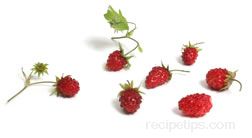 |
The original strawberries that existed, which different varieties of these berries were crossed to develop the cultivated strawberries that are more readily available today. Wild strawberries are much smaller than the cultivated berries but they are more fragrant, juicier, and sweeter. There are many varieties of wild strawberries. |
Strawberry Preparation
Cleaning | Removing Stem & Hull | Halving, Slicing, and Chopping | Mashing | Strawberry Garnish
Cleaning Strawberries
Do not clean strawberries until you are ready to use them. When ready to clean them, the strawberries should be exposed to as little water as possible. Do not wash the strawberries if it is not necessary because they are porous and will soak up water quickly. Cleaning strawberries is shown below.
Removing Stem and Hull
Strawberries can be served with the stem remaining or the stem can be removed, both are acceptable depending on how they will be used. When serving strawberries individually, the stem serves as a handle. The stems must be removed when making sauces or when used as an ingredient in desserts and other dishes. Several methods for removing the stems are shown below.
|
To remove the stem, hold the strawberry between your thumb and forefinger. Take hold of the stem between your thumb and forefinger of the opposite hand. Twist hands in opposite directions to loosen the stem and hull (core) of the strawberry and then pull them out. |
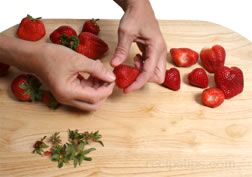
|
|
Another option, which works fairly well, is simply cutting the stem and hull out with a paring knife or small utility knife. |
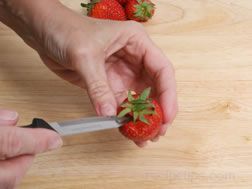
|
|
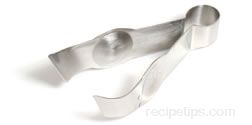
There are also tools that have been specifically designed for removing the stem and hull. A strawberry huller is one of these tools. Insert the ends of the huller into the strawberry at the stem end deep enough to get a hold of the stem and core. Squeeze the end of the huller and pull the stem and core out of the strawberry.
|
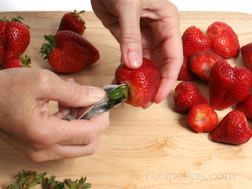 |
|

A strawberry/tomato corer is another tool designed to remove the stem and core of the strawberry. Use the sharp points on the end of the tool to dig the core and stem from the strawberry.
|
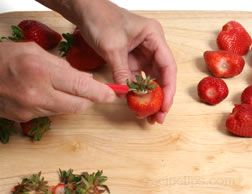 |
Halving, Slicing, and Chopping Strawberries
Strawberries are often eaten whole and do not require any further preparation but many recipes call for them to be cut up in some manner or require them to be mashed. Some of the common preparation methods called for are shown below.
|
Halving Strawberries
Clean the strawberries and remove the stems and cores as shown above.
Place the whole strawberry on a cutting board with the stem side down on the board. Starting at the pointed end, cut down through the strawberry to slice in half.
|

|
| If quarters are called for, cut halves in half again to form quartered pieces. |
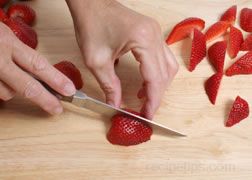 |
|
Slicing Strawberries
Clean the strawberries and remove the stems and cores as shown above.
Place the whole strawberry on a cutting board with the stem side down on the board. Start cutting slices from one side of the strawberry and continue cutting slices of desired thickness. |
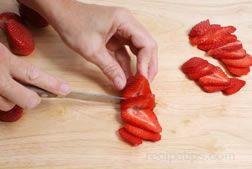
|
| Another way of slicing strawberries is to use an egg slicer. Place the strawberries in the slicer so its length is running parallel to the wires in the egg slicer. Slice through the strawberries in the same manner as slicing eggs. |
 |
| Using the egg slicer is a quick and easy slicing method that creates evenly sliced berries. |
 |
|
Chopping Strawberries
Cut strawberries in halves as shown above.
Place the strawberry halves on a cutting board with the cut side down on the board and slice lengthwise into 4 pieces. If the strawberries are large, cut the halves into 6 or more pieces, depending on the size of the berry. |
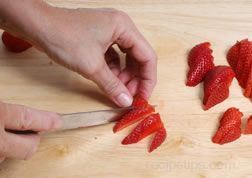 |
| After slicing the strawberries into pieces, cut them crosswise into small chopped pieces. |
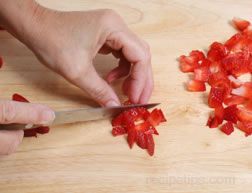 |
Mashing Strawberries
Some recipes, such as strawberry sauces, syrups and jams, call for the strawberries to be mashed or crushed. The strawberries can be mashed by hand or with a food processor. See below for some suggestions on how to mash strawberries.
| Cut strawberries in halves as shown above and then cut in half again to form quartered pieces. Place quartered pieces in a bowl. |
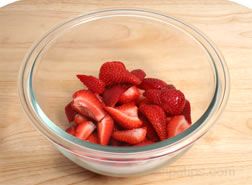 |
| Use a potato masher to mash the strawberries. The strawberries will be hard to mash when first starting. |
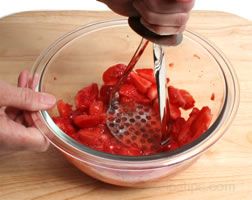 |
|
As the berries are mashed and some of their juices are released, they will begin to soften and will mash easier.
Continue to mash the strawberries until they are the desired consistency. |
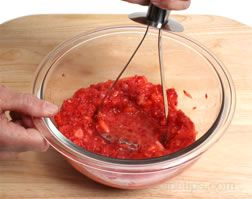 |
|
Other methods for mashing:
- The strawberries can be mashed using a fork but this method is generally more time consuming.
|
 |
- A pastry blender is another tool that can be used for mashing. The pastry blender does a good job of cutting through the strawberries.
|
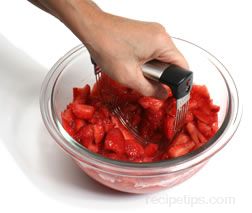 |
- Strawberries can be quickly mashed in a food processor using the pulsing action. Watch the consistency of the berries carefully because it is easy to process them more than intended. It should only take two or three pulsings.
|
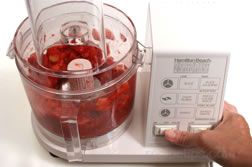 |
Strawberry Garnish
Strawberries are an easy garnish to decorate summer desserts and add color to appetizer platters. Carefully clean the strawberries and then prepare as shown below.
|
Strawberry Fan
With a paring knife, slice strawberry from a point slightly below the top stem to the bottom. Continue making thin slits from one end of the strawberry to the other. |
 |
| Gently spread the strawberry apart creating a strawberry fan. |
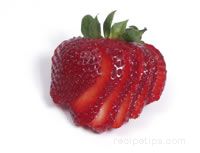 |
|
Chocolate Dipped Strawberries
Chocolate dipped strawberries can be used as both an appetizer and a garnish.
Go through the strawberries and discard any that are damaged, bruised or spoiled. To clean strawberries, gently wipe off each berry with a wet paper towel or gently rinse under cold water and drain in a colander. Leave stems attached. |
 |
| If the strawberries were rinsed, place them on paper towels to allow moisture to drain faster. Gently pat with paper towels to dry berries completely before dipping. |
 |
| Melt 4 ounces of chocolate and 1 tbsp of butter together in a double boiler or melt in the microwave. Semi-sweet, dark, milk, or white chocolate can be used. If melting in the microwave, cook on medium power at 30 second intervals. Stir after every 30 second. Do not over cook or the milk solids in the chocolate may begin to separate and the melted chocolate will become grainy. |
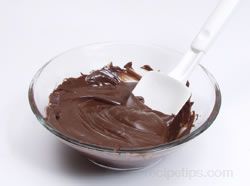 |
| When the chocolate is melted, poke a toothpick in the stem end of the strawberry before dipping. |
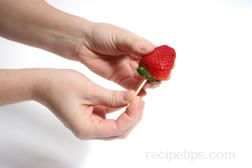 |
| Dip strawberries in the melted chocolate to coat half of the berry. After dipping, stick the toothpick into a piece of Styrofoam with the berry end up. This will prevent a flat side to the chocolate dipped berry. If you do not have Styrofoam to use, the dipped berries can be laid out on wax paper. After the strawberries are coated, they should be placed in the refrigerator until the chocolate hardens. |
 |
|
Once the chocolate has set, they can be drizzled with melted white chocolate or the tips can be dipped again in the white chocolate to give them a decorative look.
The strawberries can be served after the chocolate has set. Keep dipped strawberries in the refrigerator for up to 24 hours. |
 |
Strawberry Cooking
Strawberries can be used in many ways for cooking. They are used fresh in salads, sauces and blended drinks, and they are cooked to make syrups and sauces. They are also baked in many desserts, such as cakes, pies, tarts, cobblers, breads and muffins. Shown below are two sauces that can be used for a topping on foods, such as ice cream, cakes, tarts, waffles, pancakes, and French toast.
|
Fresh Strawberry Sauce
Clean and hull 1 pint of strawberries as shown above.
Before starting the sauce, taste a berry to determine their sweetness. This will allow you to decide if more or less sugar should be added.
Cut the strawberries into quarters and place them in a bowl to be mashed. |
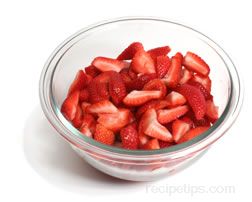 |
| Slightly mash the strawberries using a pastry blender or one of the other methods shown above. |
 |
|
After the strawberries have been mashed slightly, sprinkle with approximately 1/4 cup of sugar. More or less sugar can be used, depending on the sweetness of the berries. You may want to start with less and add more after the sauce is finished if it needs it. Gently stir the strawberries and sugar to mix them together. Place them in the refrigerator and allow them to stand for 1 to 2 hours.
The sugar will draw the juices from the strawberries and make them easier to blend. |
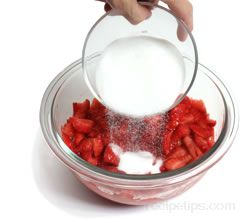 |
| After allowing the strawberries to stand, take them from the refrigerator and continue to mash until they are the desired consistency. Taste the sauce and if more sugar is necessary, add a small amount at a time to the sauce until it is at the desired sweetness. |
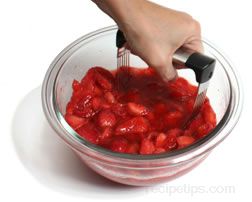 |
| The fresh strawberry sauce can be used to top shortcake, ice cream, other desserts or it can be eaten as a sauce on its own. |
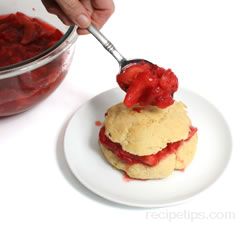 |
|
Cooked Strawberry Sauce
Clean and hull 2 pints of strawberries as shown above.
Before starting the sauce, taste a berry to determine their sweetness. This will allow you to decide if more or less sugar should be added.
After all the strawberries have the stems and hulls removed, cut the berries into slices. |
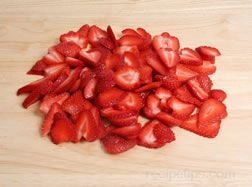 |
| Measure 2 cup of strawberry slices and set them aside. Mash the remaining berries using a potato masher or one of the other methods shown above. Mash enough berries to produce approximately 2 cups. |
 |
|
After the strawberries have been mashed, place them in a saucepan and add 2/3 cup of sugar, 6 tbsp. of water and 1 1/2 tbsp. of cornstarch. |
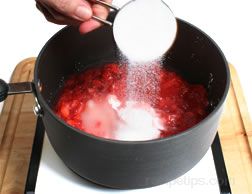 |
| Cook the mixture over medium heat until sauce thickens. Allow the sauce to boil for 1 minute. Stir continually throughout cooking time. |
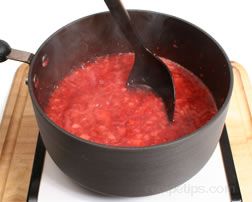 |
| After the sauce has boiled for 1 minute add the remaining strawberry slices. |
 |
| Gently stir the slices in the sauce until evenly distributed. |
 |
|
This warm sauce is great served over pancakes or other food, such as waffles, French toast, angel food cake, crepes, tarts, and ice cream.
The cooked strawberry sauce can be served warm or cold. |
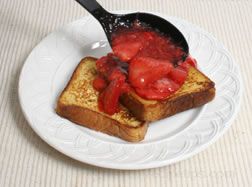 |
Freezing Strawberries
Strawberries can be frozen so they can be stored for a longer period of time. Freeze strawberries whole, sliced, or crushed and sweetened or unsweetened. Freezing strawberries will affect their texture but they will still be great for many uses, such as making jams, in pies, desserts, and as a sauce to top ice cream, cakes, waffles and pancakes.
There are several methods that can be used for freezing strawberries. Determining which method to use will depend on end use and personal preference. All methods are fairly simple. Before using any of the methods, there are some tips listed below that may help provide better quality frozen strawberries.
- Be sure to use only good quality strawberries. They should be fully ripe but still firm. Discard any bruised or spoiled berries.
- Clean the strawberries as shown above and do not hull until after cleaning. Do not allow strawberries to soak in water to avoid having them taken on excess moisture. If dry pack freezing, be sure strawberries are completely dry before freezing.
- Be sure to use airtight freezer safe containers. If using freezer bags, be sure to remove as much air from the bag as possible before sealing.
- Allow enough headspace in the freezing containers or bags before sealing to allow for expansion when the strawberries freeze. Allow approximately 1/2 inch for pint size containers and 3/4 to 1 inch for quart size containers.
- Place the strawberries in the coldest part of the freezer so that they will freeze as quickly as possible. Store berries for up to 1 year.
Selecting a Freezer Container
Before starting the freezing process you should consider what type of freezer container will be best for the method you are using. The container must be freezer proof so that it will not crack or break when the content freezes. It must also have an airtight seal to prevent moisture loss and leakage, and to keep strawberries from absorbing unwanted odors. When freezing strawberries, there are two types of packaging that can be used, rigid containers or sealable bags.
Freezing Methods
The methods for freezing strawberries are dry pack - individual tray freezing, dry pack - unsweetened, dry pack - sweetened, juice or water packed, and syrup packed. Each method is described below.
Dry Pack - Individual Tray Freezing
|
Clean and hull berries as shown above. Be sure to dry berries thoroughly.
Place the strawberries on a baking sheet in a single layer and do not cover. Place the baking sheet containing the strawberries in the coldest part of the freezer so they will freeze as quickly as possible. |
 |
|
When the strawberries have frozen solid, take them from the baking sheet and place them in an airtight freezer container or freezer bag. If a specific amount is not needed just fill the bag to a desired level. |
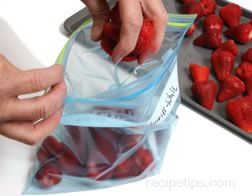 |
| Leave at least 1/2 inch headspace when packaging and be sure to remove excess air from bags before sealing. |
 |
|
Be sure to mark the container or bag with contents, quantity and date. Return the bagged strawberries to the freezer as soon as possible.
|
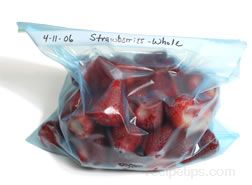 |
| Since the strawberries were frozen individually before they were placed in the bag, it will be easy to remove just the amount needed from the bag and return the remaining berries to the freezer to use at a later date. |
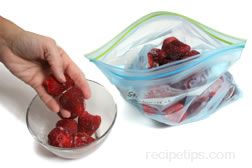 |
Dry Pack - Unsweetened
|
Clean and hull berries as shown above. Be sure to dry berries thoroughly.
The strawberries can be left whole, halved or sliced if desired. |
 |
|
Pack strawberries in freezer container or bag, leaving 1/2 inch headspace. If you are freezing the berries to be used in specific quantities, fill each container with a premeasured amount. |
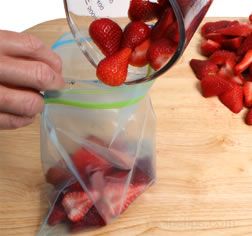 |
| If using bags, be sure to remove excess air in bags before sealing. |
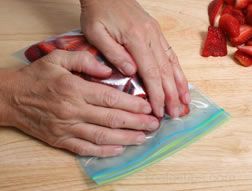 |
|
Mark the container or bag with contents, quantity and date.
Place the strawberries in the coldest part of the freezer. |
 |
Dry Pack - Sweetened
|
Clean and hull berries as shown above. Be sure to dry berries thoroughly.
Leave strawberries whole or cut into quarters or slices. Berries can also be crushed if desired. |
 |
| Place prepared strawberries in a bowl and sprinkle with sugar. Add 1/2 cup of sugar to every 4 cups of strawberries. Quantity of sugar can be adjusted according to desired taste. |
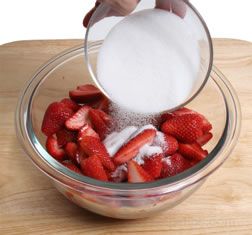 |
|
Gently stir the strawberries until the sugar is evenly distributed. Then let the strawberries and sugar stand for a short period of time to allow the sugar to draw out the natural juices from the strawberries. |
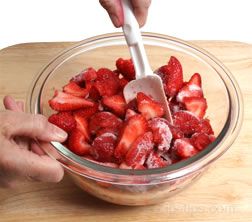 |
| After they stand for a while, 10 to 15 minutes, stir again until the sugar is all dissolved. The more the berries are stirred, the more they will breakdown. If you want to end up with chunkier pieces of strawberries, keep stirring to a minimum. |
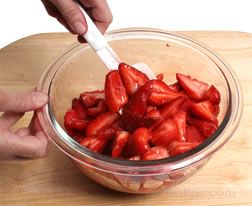 |
|
Pour a premeasured amount of strawberries and juice into freezer package, leaving 1/2 headspace. If using freezer bags, be careful the strawberries do not spill out of the bags as they are being filled. |
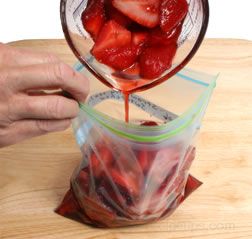 |
|
Seal containers tightly, removing excess air from bags before sealing. |
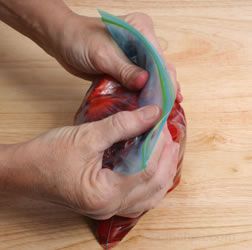 |
| Be sure to mark the container or bag with contents, quantity and date. When finished place the strawberries on a cookie sheet and put in the coldest part of the freezer. Bags can be transferred to freezer baskets once the berries are frozen. |
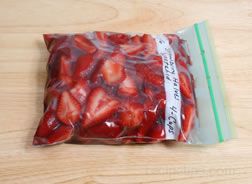 |
Juice or Water Packed
When using this method of freezng, keep in mind that the more the strawberries are cut up the more liquid they will soak up. When thawed, they will be softer and break up more easily. Depending on the end use, this may or may not be desired. If you prefer the berries remain in larger pieces after thawing, leave the strawberries whole or in halves when using this freezing method or use one of the methods above.
|
Clean and hull berries as shown above. Be sure to dry berries thoroughly.
Leave strawberries whole or cut into halves, quarters or slices and then place in freezer containers or bags. |
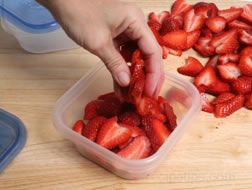 |
| Add juice or water to cover strawberries. If you are using water to cover strawberries, add lemon juice (1 tbsp. to 4 cups of water) to the water to help retain the color of the berries. |
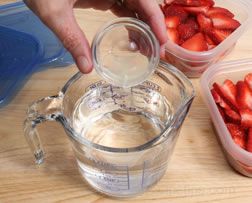 |
|
Pour enough juice or water in the freezer container or bag to cover the strawberries.
If using bags, be careful that the juice or water does not spill out of the bags as they are being filled. |
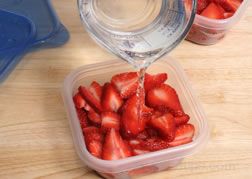 |
| There should be at least 1/2 inch headspace in the container or bag after filling. |
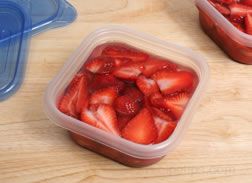 |
|
Seal the containers or bags. If using a container, be sure the cover is sealed tightly on all edges.
If using freezer bags, carefully remove excess air from bags and seal tightly. |
 |
| Mark the container or bag with contents, quantity and date, and then place the strawberries in the coldest part of the freezer. |
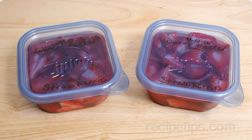 |
Syrup Packed
|
Syrup should be chilled before using so it is a good idea to prepare the syrup the day ahead of freezing the strawberries. Refrigerate overnight.
Combine 3 cups of sugar with 4 cups of water in a saucepan. For lighter syrup use only 2 cups of sugar. |
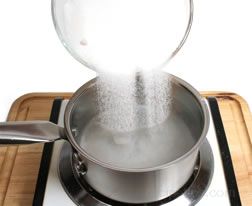 |
| Bring mixture to a boil, stirring until sugar is dissolved. Remove from heat and allow syrup to cool. |
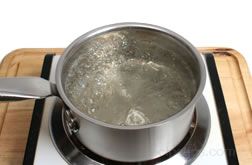 |
|
Clean and hull berries as shown above. Be sure to dry berries thoroughly.
Leave strawberries whole or cut into halves, quarters or slices. |
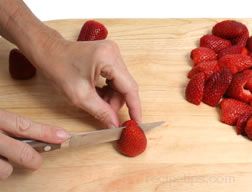 |
|
Place in the freezer containers or bags and pour syrup over the strawberries to cover them. It should take 1/2 cup or less of syrup if working with pints and 2/3 to 1 cup for quarts. |
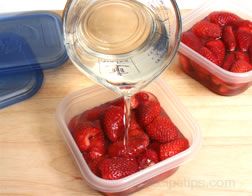 |
| Leave 1/2 inch headspace for pints and 1 inch for quarts. |
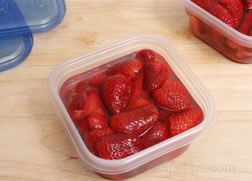 |
| Make sure the freezer container is sealed tightly. Mark the container or bag with contents, quantity and date, and then place the strawberries in the coldest part of the freezer. |
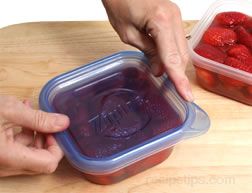 |
Tips
- Bring out the flavor of strawberries by sprinkling with a dash of pepper, balsamic vinegar, lemon juice or orange juice.
- Adding sugar, lemon juice or orange juice to strawberries will help preserve their bright color.
- When cleaning strawberries, avoid soaking them in water. Because they are so porous, strawberries will absorb the water, causing them to become waterlogged and lose some of their flavor.
- If substituting frozen strawberries for fresh berries in a recipe, substitute as follows: if strawberries are unsweetened, use equal amounts of frozen berries as called for fresh; if frozen strawberries are sweetened, reduce the amount of sugar called for in the recipe by 1 cup for each quart of strawberries; if a sugar syrup has been used to sweeten the frozen berries, reduce the amount of liquid called for in the recipe.
- One pint of fresh strawberries is equal to 2 1/2 cups whole, 1 3/4 cups sliced, 1 1/4 cups puréed, 24 medium, 36 small.
- Twelve pounds of fresh strawberries are equal to approximately 8 quarts. This quantity will produce approximately 13 pints of frozen strawberries.
|









